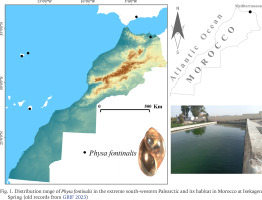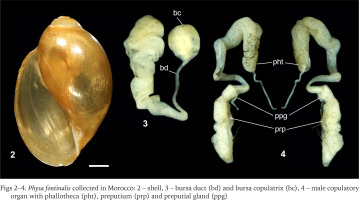INTRODUCTION
Aquatic snails belonging to family Physidae Fitzinger, 1833 are air-breathing freshwater gastropods, commonly known as the Bladder snails. Members of the family have sinistral shells, which are semi-transparent and fragile, with no operculum or umbilicus (Tachet et al. 2010). Bladder snails have slender and elongated tentacles, and the family is characterised by the presence of a preputial gland. Some species have an extended mantle margin that can partially cover the shell (Te 1978, Glöer 2019).
Also commonly known as pond snails (Bouchet & Rocroi 2005), Physidae are opportunistic aquatic gastropods, their diet includes both detritus and algae and they can inhabit all types of environments including streams, rivers, ponds, lakes, springs, canals and irrigation ditches. Additionally, they occur in both nutrient-poor and richly vegetated habitats (Glöer 2019) and are hermaphrodites. They encapsulate their eggs in a gelatinous substance that can hold between 40 and 180 eggs (Oscoz et al. 2011). Considering the water quality, they can tolerate high temperatures and salinity, and some species are resistant to organic pollution (Larraz et al. 2007, Vázquez-Capote et al. 2015).
The family Physidae is highly diverse, consisting of approximately 80 species with a cosmopolitan distribution across almost all continents (Taylor 2003). The widespread distribution of these species is largely attributed to human-mediated introductions (Albrecht et al. 2009). Previously, the only known representative of the Physidae family in Morocco was the non-native Physella acuta (Draparnaud, 1805), which is widely distributed throughout the country (Taybi et al. 2017, 2023b). Recent field surveys conducted in the Northern part of Morocco have led to the discovery of Physa fontinalis (Linnaeus, 1758), which represents the first confirmed record of this exotic species in Morocco and in North Africa as a whole.
MATERIAL AND METHODS
In order to promote knowledge on the freshwater molluscs of Morocco, several field expeditions have been conducted since 2014 in the northern part of the country, with a special focus on Protected Areas. Most of these sampling sites were visited several times. The gastropods (and benthic fauna in general) were collected using Surber samplers (20×25 cm surface area, 400 µm mesh). For each sample, a first sorting was carried out on the field during which the fauna was preserved in a jar containing alcohol. A second and finer sorting was performed in the laboratory under a binocular loupe in which all remaining macroinvertebrates were recovered and stored in alcohol up to 70% of the volume. Water conductivity, pH, and dissolved oxygen were measured in situ with a multiparametric measuring device (WTW, Multi-Line P4). Other parameters (ammonium and Biological Oxygen Demand (BOD5)) were measured in the laboratory. Photographs were made with a digital camera system (Leica Microscope M205C with digital camera Leica DMC5400). The map was made using ArcGIS software. Voucher specimens were deposited in the collections of the authors. Identifications were made using the identification key of Glöer (2019).
RESULTS
The first natural population of Physa fontinalis has been discovered in Morocco. About twenty individuals of the fountain bladder snail were collected in a small retention reservoir for waters from the Isekagen spring, as well as in its irrigation channels on 05/10/2022 and 10/09/2023 (Fig. 1). The spring is located in the north-east of Morocco (35°09′53.7″N, 3°00′06.4″W), in the province of Nador. The shell size ranged between 6.5–8 mm in height and 4–6 mm in broad.
Fig. 1
Distribution range of Physa fontinalis in the extreme south-western Palearctic and its habitat in Morocco at Isekagen Spring (old records from GBIF 2023)

The body of Physa fontinalis is brown to black and the edges of the mantle extend as finger-like lobes over the exterior of the shell, the tentacles are long, slender and cylindrical, with the eyes at the base. The shell of the fountain bladder snail is light yellowish to brownish, thin-walled, and highly glossy (Figs 2–4). The 3.5–4 whorls of the shell are rapidly growing and are separated by a weak and whitish suture. The aperture is wide and oval, the suture often weakly whitish, and the apex is obtuse and rounded, the spire has delicate stripes. All these criteria distinguish it from the other Physidae species (Glöer 2019).
Figs 2–4
Physa fontinalis collected in Morocco: 2 – shell, 3 – bursa duct (bd) and bursa copulatrix (bc), 4 – male copulatory organ with phallotheca (pht), preputium (prp) and preputial gland (ppg)

Physa fontinalis was found together with other species of freshwater snails such as Ancylus fluviatilis O. F. Müller, 1774 (Planorbidae), Melanopsis sp. (Melanopsidae) and Mercuria sp. (Hydrobiidae). Different invertebrate species can be found in the habitat of in the Isekagen spring, including: Anax parthenope (Selys, 1839), Anax imperator Leach, 1815, Trithemis kirbyi Selys, 1891, Trithemis annulata (Palisot de Beauvois, 1807), Crocothemis erythraea (Brullé, 1832) and Orthetrum sp. (Odonata, larvae and imagos); Caenis sp. and Baetis sp. (Ephemeroptera, larvae); Hydroptila sp. (Trichoptera, larvae); Laccophilus hyalinus testaceus Aubé, 1837, Laccobius sp. and Agabus sp. (aquatic Coleoptera, larvae and imagos); Gerris sp. and Corixa sp. (aquatic Hemiptera), and larvae from different dipteran families. The invasive mosquito fish Gambusia holbrooki (Girard, 1859) has been also detected in the site.
Physa fontinalis seems to require habitats with good water quality. The analysis of the physico-chemical parameters of the water (ammonium and BOD5) showed a good environmental quality of the water, according to the Moroccan standards for the quality of surface waters (Table 1).
DISCUSSION
Physa fontinalis is a Holarctic species; it has a wide distribution in the western Palaearctic, covering nearly all of Europe (Glöer 2019). In the neighbouring areas in the south-western Palearctic, the species has been recorded from the south of the Iberian Peninsula, Madeira and Canary Islands (GBIF 2023). We record it for the first time from Morocco and therefore from North Africa, increasing the known aliens of the Bladder snails to two species in Morocco. The pathways by which P. fontinalis was introduced into Morocco are unknown, although aquaristics and the ornamental plant trade remain the most likely pathways, as is the case for the majority of exotic gastropods in Moroccan freshwaters (Taybi et al. 2023b). Future surveys may reveal more occurrences of Physa fontinalis in the country and the rest of the continent.
In recent years, there has been significant progress in knowledge of the freshwater mollusc fauna of Morocco, with the addition of many new species, including genera and species that are new to science (Glöer et al. 2020a, b, Mabrouki et al. 2021, 2023a, Taybi et al. 2022, Bespalaya et al. 2023). However, the inventory list of the freshwater gastropod fauna of Morocco is certainly still incomplete. It is more important than ever to step up research into these vulnerable invertebrates, given the multiple threats they face. Freshwater habitats and biodiversity are increasingly being affected by human activities in Morocco, and freshwater ecosystems may well be the most endangered ecosystems, by water pollution in densely populated regions and leaching through permeable soils of contaminants such as water-soluble fertilisers carried by rain and irrigation (Bensaad et al. 2017, Taybi et al. 2020a, b) and particularly by animal biological invasions (Taybi et al. 2018, 2023b, Mabrouki et al. 2019).
Until recently, there was limited documentation on biological invasions and the pathways of introduction and spread of alien species in Morocco. An increasing number of invasive aquatic species have been identified, including successful freshwater molluscs such as bivalves (e.g. Corbicula fluminea (O. F. Müller, 1774) and Sinanodonta woodiana (Lea, 1834)) (Clavero et al. 2012, Mabrouki & Taybi 2022), as well as highly invasive freshwater snails like the American limpet Ferrissia californica (Rowell, 1863), the exotic seminole rams-horn Helisoma duryi (Wetherby, 1879), the Red-rimmed melania Melanoides tuberculata (O. F. Müller, 1774), the New Zealand mudsnail Potamopyrgus antipodarum (J. E. Gray, 1843) and the acute bladder snail Physa acuta (Taybi et al. 2017, 2021, 2023a, Mabrouki et al. 2023b). The discovery of P. fontinalis brings the total number of exotic gastropods found in Moroccan freshwater to six confirmed species.
Usually more tolerant and resilient than native gastropods fauna, these invasive snails well take advantage of the effects of climate change and the increasing deterioration of water quality of the freshwater ecosystems of North Africa. Hence the importance of monitoring these species in order to mitigate the impact on indigenous communities.


